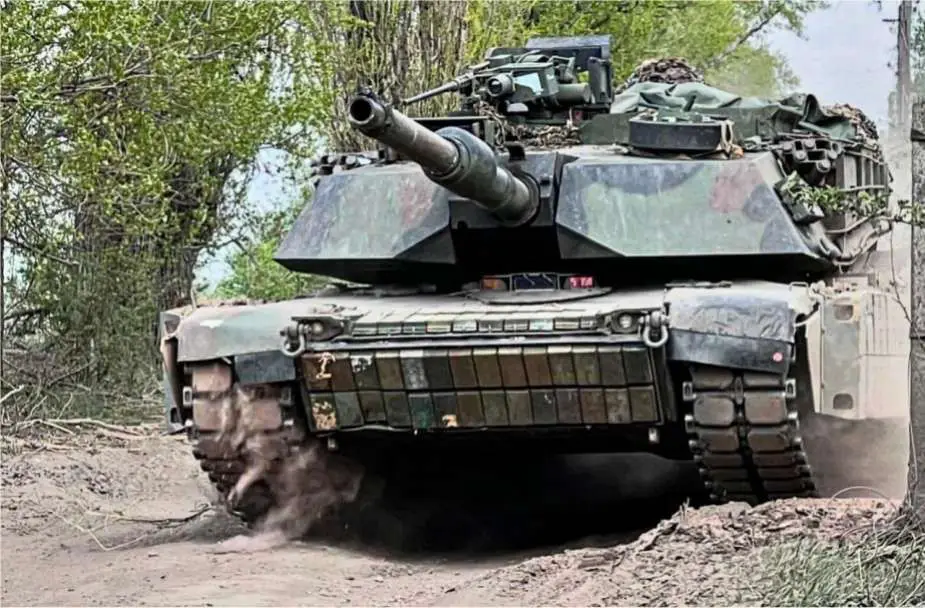Breaking News
Ukrainian Soldiers Report US M1A1 Abrams Tanks Lack Sufficient Armor Against Modern Threats Such as Drones.
Combat reports from Ukrainian soldiers reveal that the U.S.-donated M1A1 Abrams main battle tanks lack sufficient armor against modern threats such as drones, inadequately protecting personnel from attacks. Additionally, soldiers have encountered technical issues with the tanks, such as condensation affecting electronic components.
Follow Army Recognition on Google News at this link

Ukrainian soldiers have locally upgraded U.S.-donated M1A1 Abrams tanks with Kontakt-1 reactive armor. (Picture source: X Social Network)
The Ukrainian soldiers emphasized that the M1A1 Abrams tanks are not well-suited for the current Ukrainian combat environment due to newly emerged threats unknown ten years ago. In this environment, effective air power and artillery, which Ukrainian forces lack, are crucial for clearing the battlefield before the advance of tanks and troops.
The M1A1 Abrams is an advanced version of the original M1 Abrams main battle tank, which was developed by Chrysler Defense (now General Dynamics Land Systems) in response to a 1970s U.S. Army requirement for a new armored fighting vehicle. The M1A1 saw significant improvements over the original M1, particularly in terms of firepower and armor protection.
The M1A1 Abrams officially entered service with the United States Army in 1985. This iteration of the Abrams tank series brought numerous enhancements, including a more powerful 120mm smoothbore cannon, which replaced the 105mm gun found on the M1. This upgrade provided the M1A1 with superior firepower, capable of engaging and destroying a wide range of armored threats with greater effectiveness.
Regarding combat capabilities, the M1A1 is equipped with advanced fire control systems, including a ballistic computer and thermal imaging sights, which enable it to accurately target and engage enemies in various conditions, day or night. The tank's improved suspension and engine system also grant it enhanced mobility on the battlefield, allowing it to traverse diverse terrains and maintain high speeds.
The M1A1's armor protection was significantly upgraded from its predecessor. The tank features Chobham composite armor, which offers enhanced resistance against kinetic energy penetrators and shaped charge munitions. Additionally, the turret and hull of the M1A1 are designed to provide maximum protection to the crew, with improved explosive reactive armor (ERA) that adds another layer of defense against anti-tank weapons.
The combat experience of the M1A1 Abrams tanks in Ukraine has underscored the need for additional armor to counter new threats such as FPV drones, loitering munitions, and modern anti-tank weapons. In response, the Ukrainian military has demonstrated remarkable adaptability by locally upgrading the armor of these tanks to better protect them against these evolving threats.
The Ukrainian modifications, including the addition of Kontakt-1 explosive reactive armor (ERA) on the front of the tanks and anti-drone grid armor, often referred to as "Coop Cages," which cover the turret and other vulnerable sections, have proven to be highly effective. This grid armor is designed to detonate explosive warheads of drones before they can reach and damage the tank. Moreover, the Abrams tanks have been outfitted with American standard M19 Reactive Armor Tiles (ARAT) on the sides of the hull to enhance their defensive capabilities further.
Despite these upgrades, the M1A1 Abrams tanks have faced significant challenges on the battlefield. Russian drones and anti-tank weapons have proven highly effective, leading to the loss or damage of several tanks. However, the M1A1 Abrams tanks have shown resilience in the face of these threats, prompting Ukrainian forces to pull the tanks back from the front lines temporarily to reassess tactics and further improve their defenses.
These adaptations reflect the changing nature of modern warfare, where drones and advanced munitions significantly impact the effectiveness and survivability of traditional armored vehicles like the M1A1 Abrams.


























